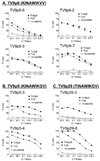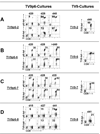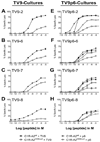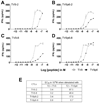Generation of robust CD8+ T-cell responses against subdominant epitopes in conserved regions of HIV-1 by repertoire mining with mimotopes
- PMID: 20432235
- PMCID: PMC3086652
- DOI: 10.1002/eji.200940079
Generation of robust CD8+ T-cell responses against subdominant epitopes in conserved regions of HIV-1 by repertoire mining with mimotopes
Abstract
HLA-A 0201-restricted virus-specific CD8(+) CTL do not appear to control HIV effectively in vivo. To enhance the immunogenicity of a highly conserved subdominant epitope, TV9 (TLNAWVKVV, p24 Gag(19-27)), mimotopes were designed by screening a large combinatorial nonapeptide library with TV9-specific CTL primed in vitro from healthy donors. A mimic peptide with a low binding affinity to HLA-A 0201, TV9p6 (KINAWIKVV), was studied further. Parallel cultures of in vitro-primed CTL showed that TV9p6 consistently activated cross-reactive and equally functional CTL as measured by cytotoxicity, cytokine production and suppression of HIV replication in vitro. Comparison of TCRB gene usage between CTL primed from the same donors with TV9 or TV9p6 revealed a degree of clonal overlap in some cases and an example of a conserved TCRB sequence encoded distinctly at the nucleotide level between individuals (a "public" TCR); however, in the main, distinct clonotypes were recruited by each peptide antigen. These findings indicate that mimotopes can mobilize functional cross-reactive clonotypes that are less readily recruited from the naïve T-cell pool by the corresponding WT epitope. Mimotope-induced repertoire diversification could potentially override subdominance under certain circumstances and enhance vaccine-induced responses to conserved but poorly immunogenic determinants within the HIV proteome.
Conflict of interest statement
Figures






Similar articles
-
Availability of a diversely avid CD8+ T cell repertoire specific for the subdominant HLA-A2-restricted HIV-1 Gag p2419-27 epitope.J Immunol. 2007 Jun 15;178(12):7756-66. doi: 10.4049/jimmunol.178.12.7756. J Immunol. 2007. PMID: 17548613 Free PMC article.
-
Despite biased TRBV gene usage against a dominant HLA B57-restricted epitope, TCR diversity can provide recognition of circulating epitope variants.J Immunol. 2008 Oct 1;181(7):5137-46. doi: 10.4049/jimmunol.181.7.5137. J Immunol. 2008. PMID: 18802118
-
Immunogenically optimized peptides derived from natural mutants of HIV CTL epitopes and peptide combinatorial libraries.Biopolymers. 2008;90(5):683-94. doi: 10.1002/bip.21020. Biopolymers. 2008. PMID: 18481808
-
The HIV-1 HLA-A2-SLYNTVATL is a help-independent CTL epitope.J Immunol. 2004 May 1;172(9):5249-61. doi: 10.4049/jimmunol.172.9.5249. J Immunol. 2004. PMID: 15100263
-
Identification of highly conserved and broadly cross-reactive HIV type 1 cytotoxic T lymphocyte epitopes as candidate immunogens for inclusion in Mycobacterium bovis BCG-vectored HIV vaccines.AIDS Res Hum Retroviruses. 2000 Sep 20;16(14):1433-43. doi: 10.1089/08892220050140982. AIDS Res Hum Retroviruses. 2000. PMID: 11018863 Review.
Cited by
-
HIV-1-Specific CD8 T Cells Exhibit Limited Cross-Reactivity during Acute Infection.J Immunol. 2016 Apr 15;196(8):3276-86. doi: 10.4049/jimmunol.1502411. Epub 2016 Mar 16. J Immunol. 2016. PMID: 26983786 Free PMC article.
-
T-cell receptor-optimized peptide skewing of the T-cell repertoire can enhance antigen targeting.J Biol Chem. 2012 Oct 26;287(44):37269-81. doi: 10.1074/jbc.M112.386409. Epub 2012 Sep 5. J Biol Chem. 2012. PMID: 22952231 Free PMC article.
-
Identification and translational validation of novel mammaglobin-A CD8 T cell epitopes.Breast Cancer Res Treat. 2014 Oct;147(3):527-37. doi: 10.1007/s10549-014-3129-x. Epub 2014 Sep 12. Breast Cancer Res Treat. 2014. PMID: 25212176 Free PMC article. Clinical Trial.
-
Empirical and Rational Design of T Cell Receptor-Based Immunotherapies.Front Immunol. 2021 Jan 25;11:585385. doi: 10.3389/fimmu.2020.585385. eCollection 2020. Front Immunol. 2021. PMID: 33569049 Free PMC article. Review.
-
The nucleocapsid protein of Rift Valley fever virus is a potent human CD8+ T cell antigen and elicits memory responses.PLoS One. 2013;8(3):e59210. doi: 10.1371/journal.pone.0059210. Epub 2013 Mar 18. PLoS One. 2013. PMID: 23527138 Free PMC article.
References
Publication types
MeSH terms
Substances
Grants and funding
- 5G12RR008124/RR/NCRR NIH HHS/United States
- UL1 TR000005/TR/NCATS NIH HHS/United States
- G12 RR008124/RR/NCRR NIH HHS/United States
- R01 AI064069/AI/NIAID NIH HHS/United States
- R43DA021175/DA/NIDA NIH HHS/United States
- R01-AI064069/AI/NIAID NIH HHS/United States
- R44 DA015212/DA/NIDA NIH HHS/United States
- R43 DA021175/DA/NIDA NIH HHS/United States
- G0501963/MRC_/Medical Research Council/United Kingdom
- R01 AI077413/AI/NIAID NIH HHS/United States
- R01-AI77413/AI/NIAID NIH HHS/United States
- R44DA015212/DA/NIDA NIH HHS/United States
LinkOut - more resources
Full Text Sources
Research Materials

